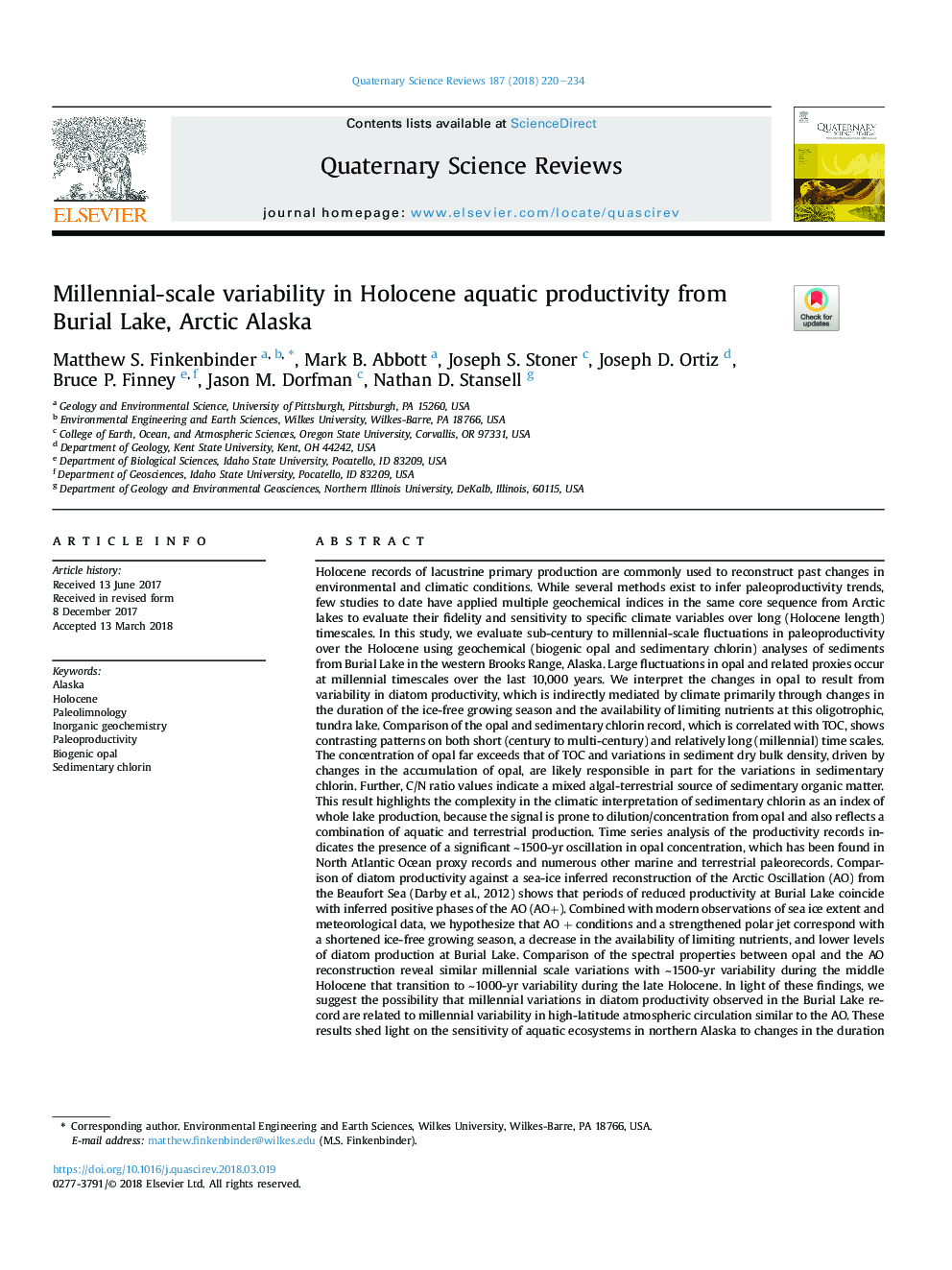| کد مقاله | کد نشریه | سال انتشار | مقاله انگلیسی | نسخه تمام متن |
|---|---|---|---|---|
| 8914870 | 1640748 | 2018 | 15 صفحه PDF | دانلود رایگان |
عنوان انگلیسی مقاله ISI
Millennial-scale variability in Holocene aquatic productivity from Burial Lake, Arctic Alaska
دانلود مقاله + سفارش ترجمه
دانلود مقاله ISI انگلیسی
رایگان برای ایرانیان
کلمات کلیدی
موضوعات مرتبط
مهندسی و علوم پایه
علوم زمین و سیارات
زمین شناسی
پیش نمایش صفحه اول مقاله

چکیده انگلیسی
Holocene records of lacustrine primary production are commonly used to reconstruct past changes in environmental and climatic conditions. While several methods exist to infer paleoproductivity trends, few studies to date have applied multiple geochemical indices in the same core sequence from Arctic lakes to evaluate their fidelity and sensitivity to specific climate variables over long (Holocene length) timescales. In this study, we evaluate sub-century to millennial-scale fluctuations in paleoproductivity over the Holocene using geochemical (biogenic opal and sedimentary chlorin) analyses of sediments from Burial Lake in the western Brooks Range, Alaska. Large fluctuations in opal and related proxies occur at millennial timescales over the last 10,000 years. We interpret the changes in opal to result from variability in diatom productivity, which is indirectly mediated by climate primarily through changes in the duration of the ice-free growing season and the availability of limiting nutrients at this oligotrophic, tundra lake. Comparison of the opal and sedimentary chlorin record, which is correlated with TOC, shows contrasting patterns on both short (century to multi-century) and relatively long (millennial) time scales. The concentration of opal far exceeds that of TOC and variations in sediment dry bulk density, driven by changes in the accumulation of opal, are likely responsible in part for the variations in sedimentary chlorin. Further, C/N ratio values indicate a mixed algal-terrestrial source of sedimentary organic matter. This result highlights the complexity in the climatic interpretation of sedimentary chlorin as an index of whole lake production, because the signal is prone to dilution/concentration from opal and also reflects a combination of aquatic and terrestrial production. Time series analysis of the productivity records indicates the presence of a significant â¼1500-yr oscillation in opal concentration, which has been found in North Atlantic Ocean proxy records and numerous other marine and terrestrial paleorecords. Comparison of diatom productivity against a sea-ice inferred reconstruction of the Arctic Oscillation (AO) from the Beaufort Sea (Darby et al., 2012) shows that periods of reduced productivity at Burial Lake coincide with inferred positive phases of the AO (AO+). Combined with modern observations of sea ice extent and meteorological data, we hypothesize that AO + conditions and a strengthened polar jet correspond with a shortened ice-free growing season, a decrease in the availability of limiting nutrients, and lower levels of diatom production at Burial Lake. Comparison of the spectral properties between opal and the AO reconstruction reveal similar millennial scale variations with â¼1500-yr variability during the middle Holocene that transition to â¼1000-yr variability during the late Holocene. In light of these findings, we suggest the possibility that millennial variations in diatom productivity observed in the Burial Lake record are related to millennial variability in high-latitude atmospheric circulation similar to the AO. These results shed light on the sensitivity of aquatic ecosystems in northern Alaska to changes in the duration of the ice-free growing season, the availability of limiting nutrients for phytoplankton growth, and Arctic-wide atmospheric circulation dynamics over the Holocene on millennial timescales.
ناشر
Database: Elsevier - ScienceDirect (ساینس دایرکت)
Journal: Quaternary Science Reviews - Volume 187, 1 May 2018, Pages 220-234
Journal: Quaternary Science Reviews - Volume 187, 1 May 2018, Pages 220-234
نویسندگان
Matthew S. Finkenbinder, Mark B. Abbott, Joseph S. Stoner, Joseph D. Ortiz, Bruce P. Finney, Jason M. Dorfman, Nathan D. Stansell,